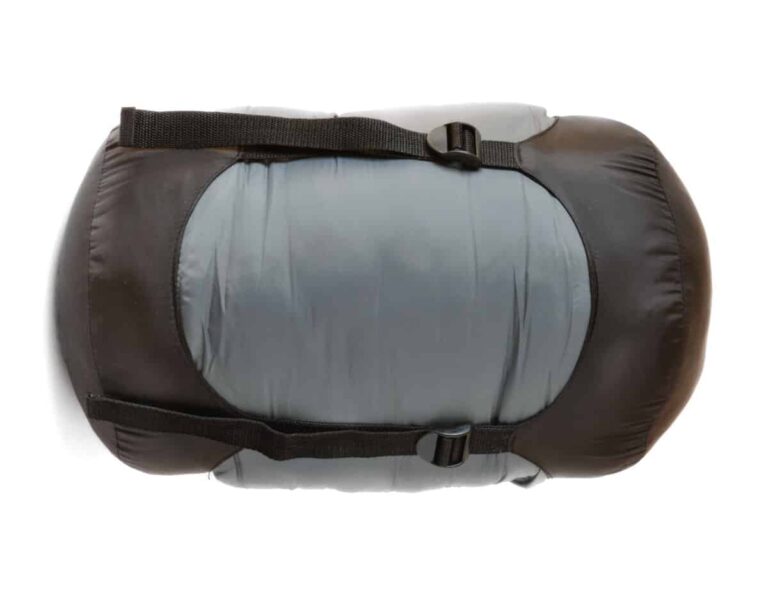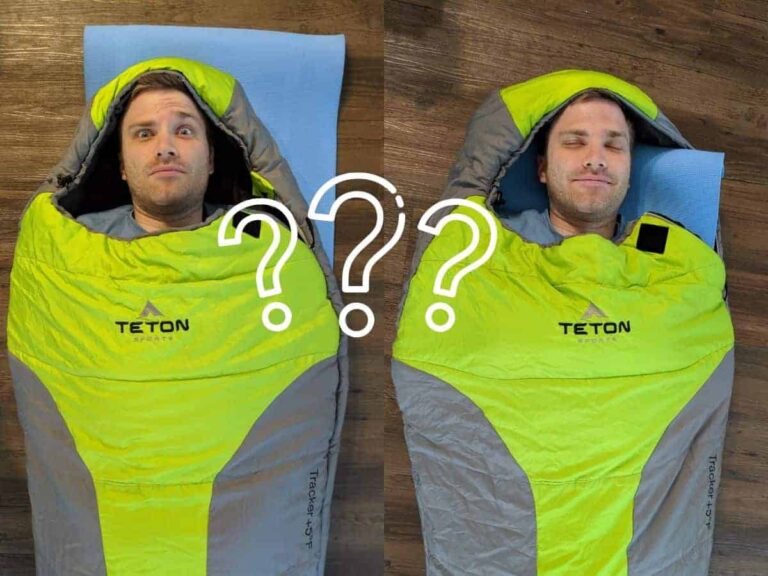Synthetic vs Down Underquilts: Pros, Cons, Price
Deciding on an
What’s the difference between synthetic vs down (fine bird feathers) filled underquilts? Synthetic and down underquilts differ mainly in price, water-tolerance, and efficiency. Synthetic underquilts are typically less expensive, and can retain their warmth better after getting wet than down, but synthetic underquilts also typically weigh more than down underquilts for the same temperature rating.
There are trade-offs with each type of underquilt, so I hope to make the choice abundantly clear whether to choose synthetic or down for your next hammocking adventure by the end of this post.

Trougnouf (Benoit Brummer)
Choosing between Synthetic or Down Underquilts
Price
A couple of examples of the price differences for the same temperature rating on Amazon.com:
| Brand/Model | Rated Temp | Filling Type | Price |
| OneTigris | 23°F to 41°F | Polyester (Synthetic) | ~$86 |
| OneTigris Cocoon | 23°F to 41°F | Goose Down Underquilt | ~$133 |
| ENO Vulcan | 35°F to 45°F | Primaloft Synergy insulation (synthetic) | ~$175 |
| ENO Blaze | 30°F to 40°F | Downtek Down (water-treated down) | ~$300 |
Far and away, feather down underquilts are more expensive than their synthetic counterparts.
Water Tolerance
In general, getting your sleeping gear wet is not exactly on everyone’s bucket list. But, it does happen. Condensation is inevitable, and sometimes even the best assembled tarp shelter still lets some rain droplets in.
Damp sleep gear gets cold and stays cold–your underquilt’s ability to insulate is affected proportional to how wet your gear is. Additionally, the fill material also determines how well the underquilt will insulate your hammock even if it gets wet.
Typically, synthetic underquilts are more water-tolerant than down. The R-value of synthetic quilts (a fancy way of saying their ability to insulate) is less impacted by some dampness than down underquilts. However, down can also be hydrophobic treated so that water is repelled from the down, which means the R-value is less impacted by some dampness.
That being said, no amount of hydrophobic treatment, and no synthetic material is immune to losing insulation effectiveness when an underquilt gets soaking wet.
In summary, although the type of underquilt you buy or make will play into its ability to resist water, it’s best to do everything you can to keep your sleeping gear dry.
Weight
Typically, synthetic underquilts are heavier than their down underquilt counterparts rated for the same temperature range. Ducks and geese have a remarkable talent that we haven’t yet mastered!
Using the ENO underquilts as an example from above here is a comparison of weight for two underquilts in the same temperature range:
- ENO Vulcan Underquilt Synthetic: 30oz
- ENO Blaze Underquilt Down: 24oz
The difference between these two quilts is not substantial in weight, unless you are a hardcore backpacker looking for any way to shave off a few ounces.
In Summary: Down is lighter than the current synthetic materials for the same temperature range for
What are the Types of Down?
If you decide to go with down, there are other factors to consider, such as what type of down should I choose?
A term used to describe down’s ability to retain loft (or air), is called fill power. The higher the fill power, the better insulation a down fill has.
Typically down comes from geese or ducks. Duck down (no, not literally) has lower fill power on average. Therefore, if you are looking for down underquilts with the highest possible fill power, then goose down is the usual choice.
That being said, the quality of quilt can make up tremendously for the difference in fill power. A high quality duck down underquilt, or even a high quality synthetic underquilt can compete with a low quality build of underquilt with goose down.
The differences between duck down and goose down for high-quality underquilts are negligible. Choosing between synthetic or down underquilts is likely to be the more important decision for you.
What Are The Types of Synthetic Fill?
Polyester
Polyester filling is common in many synthetic fillings used in jackets, sleeping bags, and underquilts. Polyester filling is fluffed up in poofy strands, which provides the insulation effect and is ubiquitous in its use in many ranges of products.
Primaloft
PrimaLoft is a patented material developed originally for the U.S. Army in the ’80s due to the need for waterproof insulation. PrimaLoft is now available commercially since the 1990s and boasts a high R-value and waterproof capabilities. Additionally, some PrimaLoft technologies feature a blend of synthetic and actual down to get advantages from both materials.
Which Type of Underquilt Should I Need?
If you go hammocking, frequently, and your current sleeping arrangement is leaving you with CBS (cold butt syndrome) and you want to step up your hammocking game, then an underquilt is a great thing to make your hammock more comfortable, and a real competitor to your tent on cold nights.
Choosing between synthetic and down underquilts should be a decision based on how much money you want to spend and your current needs. If you rarely hammock in 40 degrees Fahrenheit or lower weather, or if you are in a very humid area, then synthetic underquilts will satisfy your needs.
If, however, you need as much R-value in as little weight as possible, and you are very good at keeping your gear dry, and lastly, you don’t mind the price jumping up significantly, then a down underquilt will work great for you.
DIY Underquilts : What About Budget Options?
Underquilts are a relatively new item to be mass produced, therefore, even cheap underquilts can be relatively expensive. There are, fortunately, many DIY options out there to make your own underquilt, or at least, fulfill the same underquilt concept.
You can definitely buy new materials and spend as much as you would on a low to mid quality underquilt. However, there are some more accessible hacks
Using an Old Sleeping Bag
Option 1: Using some needlework, you can attach straps to the sleeping bag and clips which attach to the ends of your hammock, thus giving the same effect as an underquilt.
Option 2: An ingenious no-sew idea is to use another hammock directly underneath your hammock, and putting your old sleeping bag in the bottom hammock. Thus, the bottom hammock fits your top hammock allowing for the same insulating effect.
This will likely not be as effective as a genuine underquilt, but if you want to try out the concept to see if it makes it more comfortable, this is a good way to go.
One question you might have is … get another hammock? I already have one! I have 4 hammocks that I’ve gotten on sale on woot.com or on Amazon, for $20 each time. A parachute hammock doesn’t have to be expensive to be decent, workable quality.
Using a Down Blanket
There is definitely a premium for buying camping gear made for a specific purpose. You can use items not made for camping for much less than getting an underquilt. Using the same method as described for the old sleeping bag, you can sew straps to your down blanket or comforter, allowing you to attach your blanket to the front and back of your hammock.
Related Questions
- Is An Underquilt N
ecessary ? A sleeping pad, especially of high quality that has good insulation properties can provide enough insulation to help you sleep comfortably without anunderquilt . Additional steps should be taken, though, such as creating a windscreen withbrush (if allowed), or a tarp. - How Does An Underquilt Work? Insulation generally works by reducing the amount of heat-conductive surface area. Fluffy substances, such as dry duck down feathers contain a lot of air, which is a poor conductor and is ideal for trapping heat in between the feathers, which keeps you warm from the chilling and evaporative wind.




